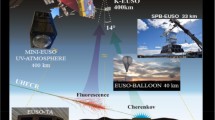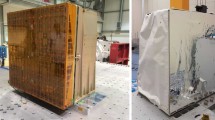Abstract
The origin and nature of extreme energy cosmic rays (EECRs), which have energies above the \(5\cdot10^{19}~\mbox{eV}\)—the Greisen-Zatsepin-Kuzmin (GZK) energy limit, is one of the most interesting and complicated problems in modern cosmic-ray physics. Existing ground-based detectors have helped to obtain remarkable results in studying cosmic rays before and after the GZK limit, but have also produced some contradictions in our understanding of cosmic ray mass composition. Moreover, each of these detectors covers only a part of the celestial sphere, which poses problems for studying the arrival directions of EECRs and identifying their sources. As a new generation of EECR space detectors, TUS (Tracking Ultraviolet Set-up), KLYPVE and JEM-EUSO, are intended to study the most energetic cosmic-ray particles, providing larger, uniform exposures of the entire celestial sphere. The TUS detector, launched on board the Lomonosov satellite on April 28, 2016 from Vostochny Cosmodrome in Russia, is the first of these. It employs a single-mirror optical system and a photomultiplier tube matrix as a photo-detector and will test the fluorescent method of measuring EECRs from space. Utilizing the Earth’s atmosphere as a huge calorimeter, it is expected to detect EECRs with energies above \(10^{20}~\mbox{eV}\).
It will also be able to register slower atmospheric transient events: atmospheric fluorescence in electrical discharges of various types including precipitating electrons escaping the magnetosphere and from the radiation of meteors passing through the atmosphere. We describe the design of the TUS detector and present results of different ground-based tests and simulations.















Similar content being viewed by others
References
J. Abraham, P. Abreu, M. Aglietta et al. (Pierre Auger Collaboration), Trigger and aperture of the surface detector array of the Pierre Auger Observatory. Nucl. Instrum. Methods A 613, 29–39 (2010)
V. Abrashkin, V. Alexandrov, Y. Arakcheev et al., Space detector TUS for extreme energy cosmic ray study. Nucl. Phys. B, Proc. Suppl. 166(0), 68–71 (2007)
V.V. Aleksandrov, D.I. Bugrov, G.K. Garipov et al., A project of investigating the most energetic cosmic rays on the Russian segment of the International Space Station. Moscow Univ. Phys. Bull. 55(6), 44 (2000)
R. Benson, J. Linsley, Satellite observation of cosmic ray air showers, in International Cosmic Ray Conference, 17th, Paris, France, July 13–25. Conference Papers, vol. 8 (1981)
F. Fenu, T. Mernik, A. Santangelo et al., ICRC-32, Beijing (2011)
G.K. Garipov, L.A. Gorshkov, B.A. Khrenov et al., AIP Conf. Proc. 433, 403–417 (1998)
G.K. Garipov, B.A. Khrenov, P.A. Klimov et al., Global transients in ultraviolet and red-infrared ranges from data of Universitetsky-Tatiana-2 satellite. J. Geophys. Res. 118(2), 370–379 (2013)
A.A. Grinyuk, A.V. Tkachenko, L.G. Tkachev (TUS Collaboration), The TUS orbital detector optical system and trigger simulation. J. Phys. Conf. Ser. 409(1), 012105 (2013)
A.V. Gurevich, K.P. Zybin, Runaway breakdown and electric discharges in thunderstorms. Phys. Usp. 44(11), 1119–1140 (2001)
B.A. Khrenov, M.I. Panasyuk, V.V. Alexandrov et al., Space program KOSMOTEPETL (projects KLYPVE and TUS) for the study of extremely high energy cosmic rays. AIP Conf. Proc. 566, 57 (2001)
B.A. Khrenov, V.P. Stulov, Detection of meteors and sub-relativistic dust grains by the fluorescence detectors of ultra high energy cosmic rays. Adv. Space Res. 37(10), 1868–1875 (2006)
J.F. Krizmanic, J.W. Mitchell, R.S. Streitmatter (OWL Collaboration), Optimization of the Orbiting Wide-angle Light collectors (OWL) mission for charged-particle and neutrino astronomy, in Proc. 33rd ICRC, Rio de Janeiro, Brazil (2013). Paper No. 1085
P.A. Klimov PhD Thesis, SINP MSU (2009) (in Russian)
P.A. Klimov, M.Yu. Zotov, N.P. Chirskaya et al., Preliminary results from the TUS ultra-high energy cosmic ray orbital telescope: registration of low-energy particles passing through the photodetector. Bull. Russ. Acad. Sci., Phys. 81(4), 407–409 (2017)
V.S. Morozenko PhD Thesis, SINP MSU (2014) (in Russian)
M.I. Panasyuk, M. Casolino, G.K. Garipov et al., The current status of orbital experiments for UHECR studies. J. Phys. Conf. Ser. 632(1), 012097 (2015)
M.I. Panasyuk, S.I. Svertilov, V.V. Bogomolov et al., RELEC mission: relativistic electron precipitation and TLE study on-board small spacecraft. Adv. Space Res. 57(3), 835–849 (2016)
V.P. Pasko, Y. Yair, C.-L. Kuo, Lightning related transient luminous events at high altitude in the Earth’s atmosphere: phenomenology, mechanisms and effects. Space Sci. Rev. 168(1), 475–516 (2012)
V.A. Sadovnichy, M.I. Panasyuk, I.V. Yashin et al., Investigations of the space environment aboard the Universitetsky-Tat’yana and Universitetsky-Tat’yana-2 microsatellites. Sol. Syst. Res. 45(1), 3–29 (2011)
L. Scarsi, Extreme Universe Space Observatory (EUSO), in Proc. First Airwatch Symposium, Catania. AIP CP, vol. 433, (1997), p. 42
F.W. Stecker, J.F. Krizmanic, L.M. Barbier et al., Observing the ultrahigh energy universe with OWL eyes. Nucl. Phys. B, Proc. Suppl. 136, 433–438 (2004)
Y. Takahashi et al., The JEM-EUSO mission. New J. Phys. 11, 065009 (2009)
N.N. Vedenkin, G.K. Garipov, P.A. Klimov et al., Atmospheric ultraviolet and red-infrared flashes from Universitetsky-Tatiana-2 satellite data. J. Exp. Theor. Phys. 113(5), 781–790 (2011)
H.D. Voss, M. Walt, W.L. Imhof, J. Mobilia, U.S. Inan, Satellite observations of lightning-induced electron precipitation. J. Geophys. Res. 103(A6), 11725 (1998)
Acknowledgements
The work was partially supported by M.V. Lomonosov Moscow State University through its “Prospects for Development” program (“Perspektivnye Napravleniya Razvitiya”), by ROSCOSMOS grants and by RFFI grants No. 16-29-13065 and No. 15-35-21038. I.H. Park was supported by the National Research Foundation grant funded by MSIP of Korea (No. 2015R1A2A1A01006870).
Author information
Authors and Affiliations
Corresponding authors
Additional information
The Lomonosov Mission
Edited by Yuri Shprits, Hans Bloemen and Jim Burch
Rights and permissions
About this article
Cite this article
Klimov, P.A., Panasyuk, M.I., Khrenov, B.A. et al. The TUS Detector of Extreme Energy Cosmic Rays on Board the Lomonosov Satellite. Space Sci Rev 212, 1687–1703 (2017). https://doi.org/10.1007/s11214-017-0403-3
Received:
Accepted:
Published:
Issue Date:
DOI: https://doi.org/10.1007/s11214-017-0403-3




